Using body temperature to diagnose disease or injury in a Soay sheep
There is no more reliable way to start diagnosing a failing lamb, a sick Soay of any age, or shock from injury, than to take the animal’s temperature. Almost without fail, if the temperature is normal, any listlessness, limping or other indication of a problem will be structural (e.g., rock in foot, temporary diarrhea caused by changing abruptly from hay to green grass) and not pathological. An inexpensive digital thermometer is the shepherd’s best ally for quick diagnosis.
In our experience, a low newborn temperature always means the lamb has not yet nursed, plain and simple, either because it is taking its sweet time to get started or for some reason (pathological or structural) it is too weak. The little lamb’s body is behaving as though it were in shock, marshalling all the lamb’s resources to stay warm. In the last two years, we have had 13 newborn lambs (out of more than 150 Soay lambs born on our farm) with temperatures below 102, what the sheep experts would call “below normal,” during the lambs’ first 2-4 hours after birth. Of those, only one died, a lamb that started at 99.3F and despite drenching and tube-fed colostrum, never had enough strength to nurse and died within ten hours. We drenched two more of those “cool” lambs. The remaining ten lambs each got up and nursed promptly enough that we did not feel the need to intervene. All twelve are healthy and thriving.
Here’s one of my favorite fully-pedigreed British yearling ewes, Pateley, shown at age 12 months — in the center of this photograph — and looking none the worse for having started out chilly:
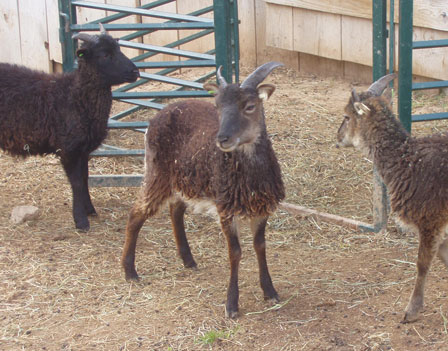
Regal and long-legged, Pateley began life quite large, but “shivering” (from my notes on her lambing card) and not very robust. She had a temperature of only 101.2 about 10 hours after she was born in late April 2007. We gave her a 2.5 cc dose of Nutradrench and then monitored her temperature — 101.5F an hour later and a reassuring 102.0 seven hours after that. As I write this post in January 2009, Pateley is about to leave the breeding area she has been in for two months with Finsbay, an equally good-looking 2-year old British ram. We have high hopes for their offspring!
The other lamb we drenched, Thirsk, had a scary temperature of only 100.6 four hours after he was born, at a time when he should have nursed and gotten his first colostrum. That one drenching was all it took to get him jump-started. Thirsk is in line to breed one of our British conservation groups of ewes in 2010. This picture (Thirsk is on the left) was taken in December, when he was 20 months old, again having more than recovered from his slow start. The green tape flopping off his right horn is part of a color-coded identification system we are trying out to allow us to observe and evaluate our rams without always having to catch them, but that’s another story for another post.
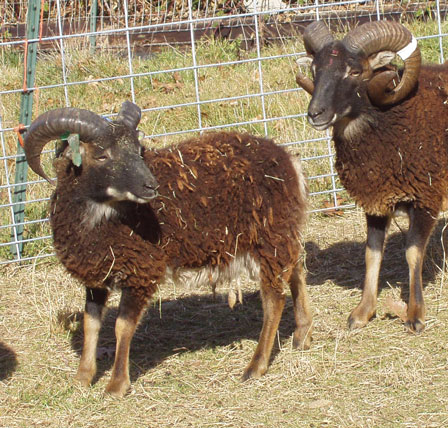
Once in a while a lamb will start out with a healthy temperature but then fail to “get it” in the nursing department, either because it is born slightly weak or just cannot figure out the nursing routine, with the result that the lamb’s temperature starts falling and it may need our intervention. Let me give you an example: one of our ram lambs this year started out just fine at 102.0 shortly after birth in early evening. Here they are, mother Coda and baby Askham, about 15 minutes after he was born:
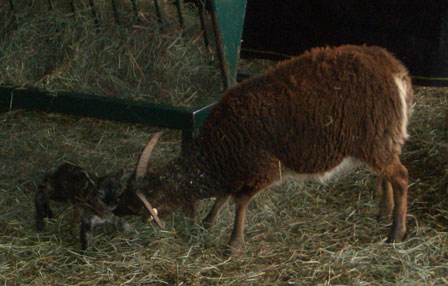
By the next morning, little Askham’s temperature had dropped to 99.4. Thankfully, we had decided to check him because he was listless and just not behaving like the miniature gluttons we are accustomed to. Steve immediately stripped his mother’s milk and tube fed him; his temperature returned to 102.4 in three hours, but he remained weak for the rest of the day and until late that night. The morning of the third day, his temperature was fine, but he developed a crusted eye (often a sign of something else amiss), so we treated it with an ophthalmalic ointment. When his temperature dropped during that third day to 101.5, we again stripped his mother’s milk and tube fed him. By the fourth day, his temperature had dropped a little more, to 101.3, but his tummy felt full and he slowly regained strength.
The great news about Askham is that he turned it around and today is one of our most robust 2008 ram lambs. Just a few more pictures tell the tale.
Here he is with mama Coda on April 11, 2008 at the age of 3 weeks. His coat is full and clean, and although Coda looks pretty ratty from shedding her coat, she also is healthy and comfortably able to provide him with enough milk without herself becoming too thin or wasted.
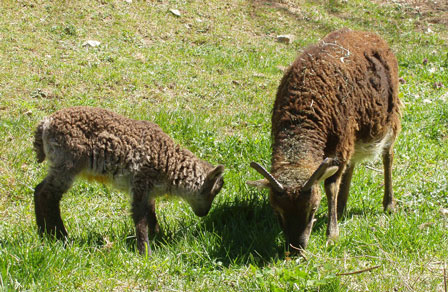
A few weeks later, when Askham was just about two months old, he and his now-sleek mother posed together in the middle of this photograph to show off his continuing growth and emerging horns:
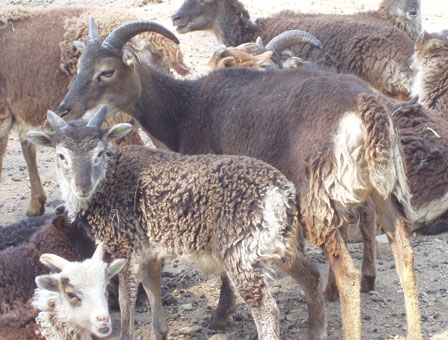
By December, the 2008 ram lamb crop had nearly finished their first rut as sexually mature rams (although still too small to try for alpha ram status against the older fellows) and Askham’s horns had grown enough to make him “competitive” with his 2008 buddies. Here is his strutting his stuff in the bull pen, campaigning to be placed in the lineup to breed next year. To this day we do not know what was ailing him those first few days or whether he would have made it on his own, but with his breeding potential we didn’t want to take the chance of losing him.
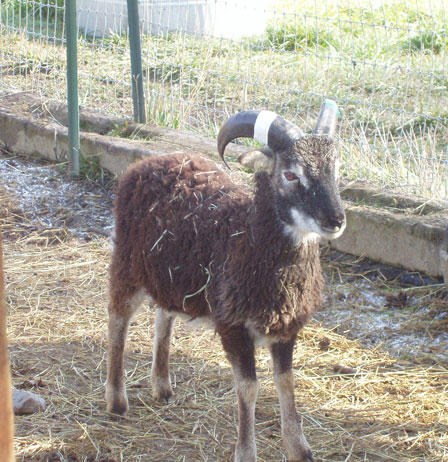
True to the legendary hardiness of Soay sheep, we have had only an occasional diseased or injured animal. In each case, temperature was one of the clues that the problem was pathological, just as in humans — fever indicating inflammation or infection, or low temperature an indication of shock after injury. When a sheep has appeared to be injured and we have taken its temperature, one of two situations obtained. A normal temperature reassured us that the animal was not in shock and we could spend some time observing its behavior before deciding whether to seek professional assistance for broken bones or whatever. An abnormally low temperature, on the other hand, has sent us to the vet immediately on two occasions, once for a little lamb in shock from being “played” with (an overly enthusiastic puppy simply licked and pawed the little lamb until it went into shock) and once for a ram who apparently had bashed too hard into another ram or a wooden fencepost, leaving him dazed and with what turned out to be a neck injury.
Thankfully, both of the injured animals came back to full health; these little guys really are hardy. But if you are unfortunate enough to have an accident or sickness occur in your flock, you will have a good first indication of whether it is serious by the animal’s temperature.
For now …